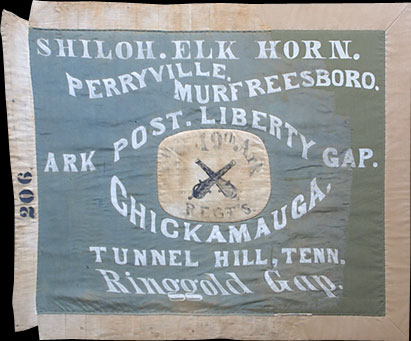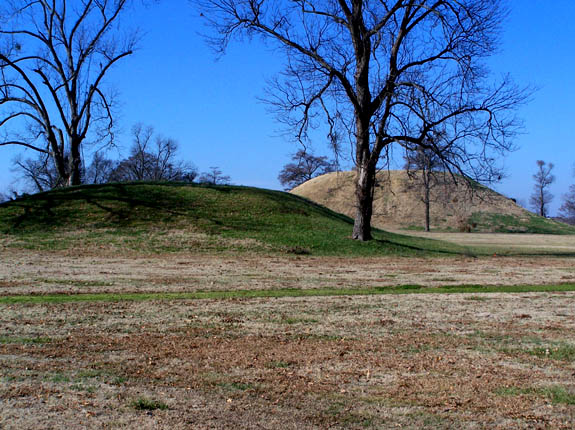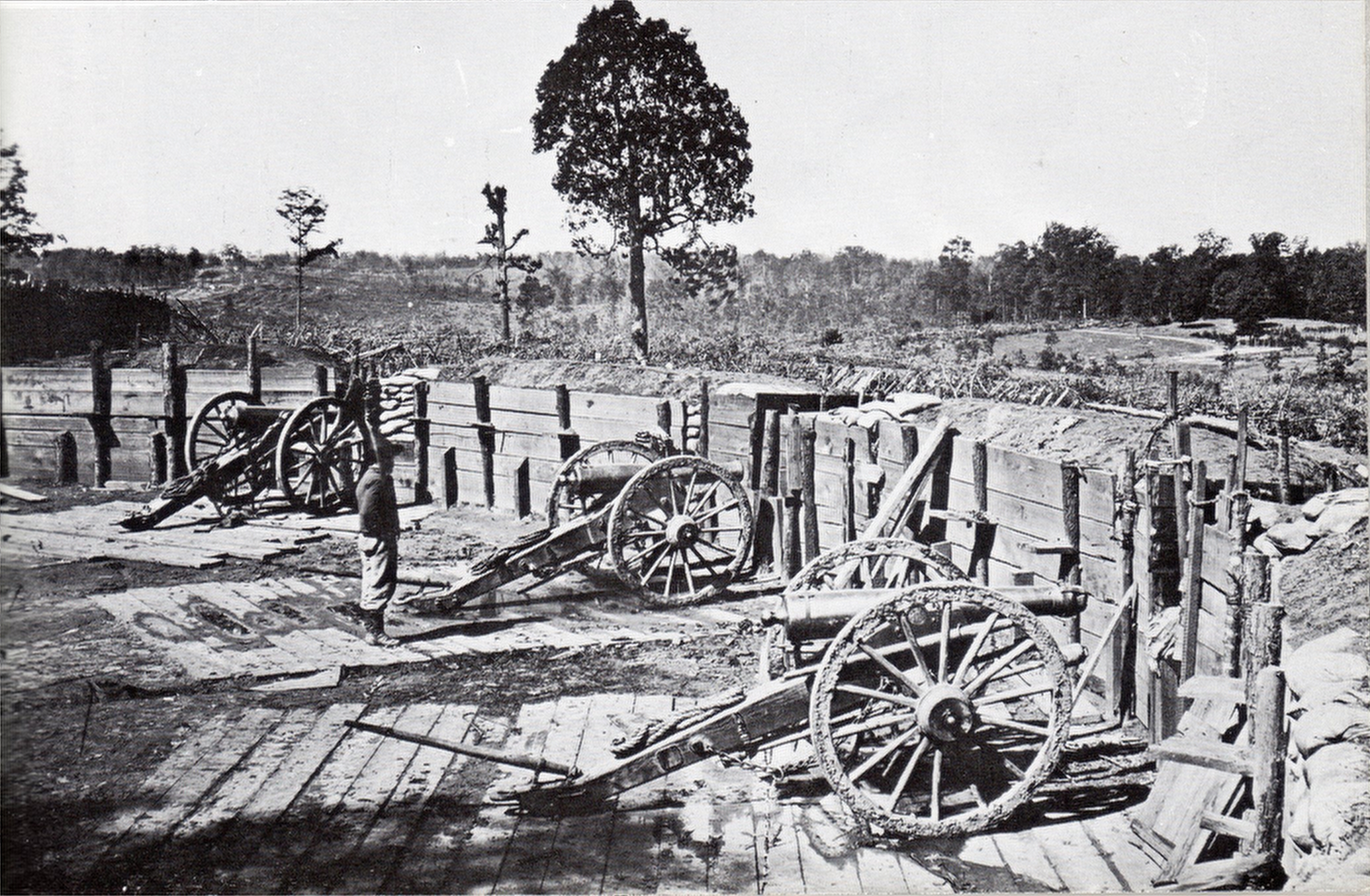|
19th (Dawsons's) Arkansas Infantry
The 19th (Dawson's) Arkansas Infantry (1861–1865) was a Confederate Army infantry regiment during the American Civil War. The regiment was present for but not engaged during the Battle of Pea Ridge. At the Battle of Arkansas Post, the regiment became split, with part of the regiment surrendering with the garrison when the post capitulated. The captured portion of the regiment was eventually exchanged and released on the east side of the Mississippi and served the remainder of the war with the Confederate Army of Tennessee. The un-captured portion of the regiment was consolidated with the remnants of the 24th Arkansas and served the remainder of the war in the Department of the Trans-Mississippi. Organization 19th (Dawson's) Infantry Regiment completed its organization at Nashville, Arkansas, in November 1861. The field officers were Colonel C. L. Dawson; Lieutenant Colonels A. S. Hutchison and P. R. Smith; and Majors Joseph Anderson, David H. Hamiter, and John G. McKean. The u ... [...More Info...] [...Related Items...] OR: [Wikipedia] [Google] [Baidu] |
Arkansas
Arkansas ( ) is a landlocked state in the West South Central region of the Southern United States. It borders Missouri to the north, Tennessee and Mississippi to the east, Louisiana to the south, Texas to the southwest, and Oklahoma to the west. Its name derives from the Osage language, and refers to their relatives, the Quapaw people. The state's diverse geography ranges from the mountainous regions of the Ozark and Ouachita Mountains, which make up the U.S. Interior Highlands, to the densely forested land in the south known as the Arkansas Timberlands, to the eastern lowlands along the Mississippi River and the Arkansas Delta. Previously part of French Louisiana and the Louisiana Purchase, the Territory of Arkansas was admitted to the Union as the 25th state on June 15, 1836. Much of the Delta had been developed for cotton plantations, and landowners there largely depended on enslaved African Americans' labor. In 1861, Arkansas seceded from the United St ... [...More Info...] [...Related Items...] OR: [Wikipedia] [Google] [Baidu] |
Battle Of New Hope Church
The Battle of New Hope Church (May 25–26, 1864) was a clash between the Union Army under Major General William T. Sherman and the Confederate Army of Tennessee led by General Joseph E. Johnston during the Atlanta Campaign of the American Civil War. Sherman broke loose from his railroad supply line in a large-scale sweep in an attempt to force Johnston's army to retreat from its strong position south of the Etowah River. Sherman hoped that he had outmaneuvered his opponent, but Johnston rapidly shifted his army to the southwest. When the Union XX Corps under Major General Joseph Hooker tried to force its way through the Confederate lines at New Hope Church, its soldiers were stopped with heavy losses. Earlier in May, Sherman successfully maneuvered Johnston's army into retreating from three separate defensive positions. However, when Sherman's army crossed the Etowah River and attempted to move around Johnston's left flank, the Confederate general anticipated his opponent' ... [...More Info...] [...Related Items...] OR: [Wikipedia] [Google] [Baidu] |
19th Arkansas Infantry Regiment (Dockery's)
The 19th Arkansas Infantry Regiment or Dockery's Arkansas Infantry Regiment was an infantry formation of the Confederate States Army during the American Civil War. There were two other regiments which were designated as the 19th Arkansas. Dawson's 19th Arkansas Infantry was organized at Nashville, Arkansas, on November 21, 1861. Hardy's Arkansas Infantry, which is also occasionally referred to as the 19th Arkansas was organized in 1863 from those parts of Dawson's 19th Infantry Regiment, the 24th Arkansas Infantry Regiment and Crawford's Arkansas Infantry Battalion, which escaped capture at the Battle of Arkansas Post. Organization The 19th Arkansas Infantry Regiment was organized on April 2, 1862, at DeValls Bluff, with Col. Hamilton P. Smead in command. The regimental quartermaster was Capt. Thomas P. Dockery, future brigadier-general. The regiment comprised ten companies from Columbia, Hot Spring, Lafayette, Ouachita and Union counties. The unit was composed of volunteer co ... [...More Info...] [...Related Items...] OR: [Wikipedia] [Google] [Baidu] |
18th Arkansas Infantry Regiment (Marmaduke's)
The 18th Arkansas Infantry (Marmaduke's) (1861–1865) was a Confederate Army infantry regiment during the American Civil War. The unit was also briefly identified as the 1st Arkansas Infantry Battalion. The unit was most often referred to as the 3rd Confederate Infantry Regiment. The designation "Confederate Infantry Regiment" was intended to convey the difference between Provisional Confederate Army units and Regular Confederate Army Units, with Provisional units being those regiments who received a state designation such as "XX Arkansas Infantry Regiment". In practice, the designation was most often utilized when Regiments were assembled utilizing companies from more than one Confederate state. The "3rd Confederate Infantry Regiment" is occasionally misidentified as the 3rd Arkansas Infantry Regiment commanded by Colonel Van H. Manning. Organization The 18th Arkansas Infantry started out as 7 of 22 companies which comprised the so-called "Hindman Legion." Col. Thomas C. Hindma ... [...More Info...] [...Related Items...] OR: [Wikipedia] [Google] [Baidu] |
Battle Of Bentonville
The Battle of Bentonville (March 19–21, 1865) was fought in Johnston County, North Carolina, near the village of Bentonville, as part of the Western Theater of the American Civil War, Western Theater of the American Civil War. It was the last battle between the western field armies of William Tecumseh Sherman, William T. Sherman and Joseph E. Johnston. As the right wing of Sherman's army under command of Maj. Gen. Oliver Otis Howard, Oliver O. Howard marched toward Goldsboro, North Carolina, Goldsborough, the left wing under command of Maj. Gen. Henry Warner Slocum, Henry W. Slocum encountered the entrenched men of Johnston's army. On the first day of the battle, the Confederates attacked the XIV Corps (Union Army), XIV Corps and routed two divisions, but the rest of Sherman's army defended its positions successfully. The next day, as Sherman sent reinforcements to the battlefield and expected Johnston to withdraw, only minor sporadic fighting occurred. On the third day, as sk ... [...More Info...] [...Related Items...] OR: [Wikipedia] [Google] [Baidu] |
Battle Of Nashville
The Battle of Nashville was a two-day battle in the Franklin-Nashville Campaign that represented the end of large-scale fighting west of the coastal states in the American Civil War. It was fought at Nashville, Tennessee, on December 15–16, 1864, between the Confederate States Army, Confederate Army of Tennessee under Lieutenant General (CSA), Lieutenant General John Bell Hood and the Union Department of the Cumberland, Army of the Cumberland (Dept. of the Cumberland) (AoC) under Major general (United States), Major General George H. Thomas. In one of the largest victories achieved by the Union army during the war, Thomas attacked and routed Hood's army, largely destroying it as an effective fighting force. Military situation Hood followed up his defeat in the Atlanta Campaign by moving northwest to disrupt the supply lines of Maj. Gen. William T. Sherman from Chattanooga, Tennessee, Chattanooga, hoping to challenge Sherman into a battle that could be fought to Hood's a ... [...More Info...] [...Related Items...] OR: [Wikipedia] [Google] [Baidu] |
Battle Of Franklin II
The Battle of Franklin was fought on November 30, 1864, in Franklin, Tennessee, as part of the Franklin–Nashville Campaign of the American Civil War. It was one of the worst disasters of the war for the Confederate States Army. Confederate Lieutenant General John Bell Hood's Army of Tennessee conducted numerous frontal assaults against fortified positions occupied by the Union forces under Major General John Schofield and was unable to prevent Schofield from executing a planned, orderly withdrawal to Nashville. The Confederate assault of six infantry divisions containing eighteen brigades with 100 regiments numbering almost 20,000 men, sometimes called the "Pickett's Charge of the West", resulted in devastating losses to the men and the leadership of the Army of Tennessee—fourteen Confederate generals (six killed, seven wounded, and one captured) and 55 regimental commanders were casualties. After its defeat against George H. Thomas in the subsequent Battle of Nashville ... [...More Info...] [...Related Items...] OR: [Wikipedia] [Google] [Baidu] |
Battle Of Jonesboro
The Battle of Jonesborough (August 31–September 1, 1864) was fought between Union Army forces led by William Tecumseh Sherman and Confederate States of America, Confederate forces under William J. Hardee during the Atlanta Campaign in the American Civil War. On the first day, on orders from Army of Tennessee commander John Bell Hood, Hardee's troops attacked the Federals and were repulsed with heavy losses. That evening, Hood ordered Hardee to send half his troops back to Atlanta. On the second day, five Union corps converged on Jonesboro, Georgia, Jonesborough (modern name: Jonesboro). For the only time during the Atlanta Campaign, a major Federal frontal assault succeeded in breaching the Confederate defenses. The attack took 900 prisoners, but the defenders were able to halt the breakthrough and improvise new defenses. Despite facing overwhelming odds, Hardee's corps escaped undetected to the south that evening. Thwarted in his earlier attempts to force Hood to abandon At ... [...More Info...] [...Related Items...] OR: [Wikipedia] [Google] [Baidu] |
Battle Of Atlanta
The Battle of Atlanta took place during the Atlanta Campaign of the American Civil War on July 22, 1864, just southeast of Atlanta, Georgia. Continuing their summer campaign to seize the important rail and supply hub of Atlanta, Union forces commanded by William Tecumseh Sherman overwhelmed and defeated Confederate forces defending the city under John Bell Hood. Union Major General James B. McPherson was killed during the battle, the second-highest-ranking Union officer killed in action during the war. Despite the implication of finality in its name, the battle occurred midway through the Atlanta campaign, and the city did not fall until September 2, 1864, after a Union siege and various attempts to seize railroads and supply lines leading to Atlanta. After taking the city, Sherman's troops headed south-southeastward toward Milledgeville, the state capital, and on to Savannah with the March to the Sea. The fall of Atlanta was especially noteworthy for its political ra ... [...More Info...] [...Related Items...] OR: [Wikipedia] [Google] [Baidu] |









